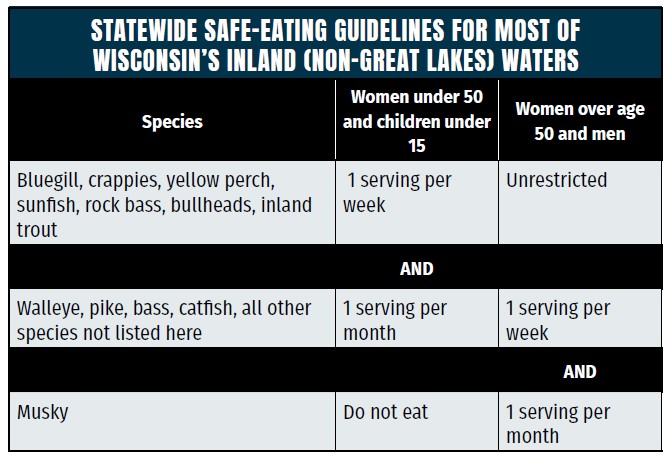Eating your catch - making healthy choices
Fishing Wisconsin
Eating your catch can be part of a healthy, balanced diet. Fish are generally low in unhealthy saturated fats and high in protein. Fish contain vitamins and minerals and are the primary food source for healthy omega-3 fats. Studies suggest that omega-3 fats may be beneficial during the fetal brain and eye development, and eating modest amounts of fish containing these healthy fats may lower the risk of heart disease in adults. Health experts recommend that fish be included as part of a healthy diet.
However, fish may take in pollutants from their environment and food. Mercury, PCBs, and PFAS are the contaminants of most significant concern in fish, prompting recommendations that people limit or avoid eating certain fish species from many waters throughout the nation. You can get the health benefits of eating Wisconsin's fish while reducing potential health risks from unwanted pollutants by following Wisconsin’s fish consumption guidelines.
Compare the type of fish and where you caught your fish with the consumption advice. After consulting the recommendations, you may find that you do not have to change your eating habits, you may choose to eat different types of fish or eat some species less frequently.
Choose Wisely publication
The DNR’s current fish consumption advisories are available in Choose wisely: a health guide for eating fish in Wisconsin [PUB-FH-824].
Also, the Choose Wisely publication is available for our Hmong and Spanish anglers.
- Xaiv Tau Yam Ntse: phau ntawv qhia txog kev noj qab haus huv rau kev noj ntses nyob hauv Wisconsin [PUB-FH-824]
- Elija Sabiamente: guía de sanidad para comer pescado en Wisconsin [PUB-FH-824]
Find advice for your fishing spot
Use the online query tool to select the water that you'll be fishing.
General statewide safe-eating guidelines
Safe-eating guidelines apply to fish from most of Wisconsin’s inland – i.e. non-Great Lakes – waters. Exceptions apply to some locations including the Great Lakes (see map below).
Exceptions to statewide safe-eating guidelines
Exceptions to the statewide safe-eating guidelines are necessary for some species of fish from 146 waters where fish have higher concentrations of mercury or other contaminants. Follow the advice for the species and length of fish you eat - to properly measure your fish, measure from the tip of the nose to the end of the tail.
Choose wisely for safe eating - videos
- Eating your catch - choose wisely [exit DNR]
- Comer Tu Captura - A Escoger Prudentamente [exit DNR]
- Noj Cov Ntses Koj Nuv [exit DNR]




